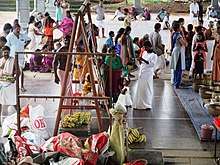Sixteen great gifts
The sixteen great gifts (Sanskrit: Shodasha-Maha-dana; IAST: Ṣoḍaśa-Mahā-dāna) refers to a category of ritual donations mentioned in the Puranic texts of ancient India.

The most prominent of these donations include the tula-purusha — weighing of a person and the donation of equivalent weight in gold, and hiranya-garbha — the donation of a golden pot.
History
The earliest inscriptions that mention the sixteen great gifts as a category date from the 8th century onward, but these great gifts have been described in the earlier literature, such as the Matsya Purana.[1] Some of these donations included in the category pre-date the concept of sixteen great gifts. For example, the Atharvaveda-parishishta, composed in the 1st millennium BCE, describes tula-purusha, hiranya-garbha, and gosahasra.[2]
The section of the Matsya Purana that mentions the sixteen great gifts appears to have been composed during 550-650 CE.[3] It states that several ancient kings performed the great gifts.[2] The Linga Purana also mentions the sixteen great donations; according to R. C. Hazara, the relevant portion of the text was composed during c. 600-1000 CE, most probably after 800 CE. The great gifts are also described in the later digests devoted to the topic of charity (dāna), such as Ballala's Dana-sagara, and the Danakhanda section of Hemadri's Chaturvarga-chintamani (13th century).[2]
The Chalukya king Pulakeshin I (c. 540-567) is known to have performed the hiranyagarbha ritual (although not mentioned as a Great Gift) to proclaim his sovereignty.[4] The earliest known epigraphically-attested donations called the "great gifts" were made by the 7th century Pandya king Jayantavarman (alias Cendan). According to his inscription, the king performed three of the great gifts: hiranya-garbha, go-sahasra, and tula-pursuha.[1] The Rashtrakuta king Dantidurga (c. 753 CE) performed a Great Gift (mahadana) ceremony, apparently as a replacement for the Vedic shrauta rituals. By the time of the imperial Cholas (c. 10th century), the Great Gift ceremony had become the principal sign of a king's beneficence, overlordship, and independence.[5]
The inscriptions of the Gahadavala dynasty (11th-12th century) mention three of the great gifts: tulapurusha, gosahasra, and pancha-langala (or pancha-langalaka). The Chandela king Dhanga (r. c. 950-999 CE) and the Kalachuri king Yashahkarna (r. c. 1073-1123 CE) are known to have performed tulapurusha. The Sena king Lakshmana Sena (r. c. 1178-1206) performed the great gift of Hemashva-ratha, otherwise called Hiranyashva-ratha.[6]
In the Vijayanagara Empire of the 14th-16th centuries, the Great Gift ceremonies were used to proclaim the rulers' beneficence and independence.[7] For example, the Nallur inscription of king Harihara II of Vijayanagara Empire mentions that he performed the sixteen great gifts.[5]
List of the great gifts
The sixteen great gifts, according to the Matsya Purana, are as follows: (names in IAST)[8][1]
- Tulā-puruṣa (Tula-purusha), the gift of the man on the scales (weighing of a person and donation of equivalent weight in gold)
- Hiraṇya-garbha, the gift of the golden embryo (pot)
- Brahmāṇḍa, the gift of the Brahma-egg
- Kalpa-pādapa, the gift of the wish-granting tree
- Go-sahasra, the gift of a thousand cows
- Hiraṇya-kāmadhenu, the gift of the wish-granting cow
- Hiraṇyāśva (Hiranyashva), the gift of the golden horse
- Pañca-lāṅgala (Pancha-langala), the gift of the five ploughshares
- Dhārā (or Prithvi), the gift of the earth
- Hiraṇyāśva-ratha (Hiranyashva-ratha), the gift of the golden horse chariot
- Hema-hasti-ratha, the gift of the golden elephant chariot
- Viṣṇu-cakra (Vishnu-chakra), the gift of the universal wheel
- Kalpa-latā, the gift of the wish-granting vines
- Sapta-sāgara, the gift of the seven seas
- Ratna-dhenu, the gift of the jewel-cow
- Mahā-bhūta-ghaṭa, the gift of the pot of elements
The two most-frequently mentioned great gifts in the historical records are tula-purusha and hiranya-garbha.[5] The Matysa Purana mentions tula-purusha as the first and the best among the sixteen great gifts.[9]
References
- Florinda De Simini 2016, p. 32.
- Annette Schmiedchen 2006, p. 146.
- Annette Schmiedchen 2006, pp. 145-146.
- Daud Ali 2000, p. 146.
- Nicholas B. Dirks 1993, p. 37.
- V. B. Mishra 1970, p. 70.
- Nicholas B. Dirks 1993, pp. 37-38.
- D. C. Sircar 1971, p. 164.
- Annette Schmiedchen 2006, p. 145.
Bibliography
- Annette Schmiedchen (2006). "The Ceremony of Tulāpuruṣa: The Purāṇic Concept and the Epigraphical Evidence". In Adalbert J. Gail; Gerd J. R. Mevissen; Richard Salomon (eds.). Script and Image: Papers on Art and Epigraphy. Motilal Banarsidass. ISBN 978-81-208-2944-2.CS1 maint: ref=harv (link)
- D. C. Sircar (1971). Studies in the Religious Life of Ancient and Medieval India. Motilal Banarsidass. ISBN 978-81-208-2790-5.CS1 maint: ref=harv (link)
- Daud Ali (2000). "Royal Eulogy as World History: Rethinking Copper-Plate Inscriptions in Cola India". Querying the Medieval: Texts and the History of Practices in South Asia. Oxford University Press. ISBN 978-0-19-512430-9.CS1 maint: ref=harv (link)
- Florinda De Simini (2016). "Manuscripts, Ritual, and the State in Indian Sources". Of Gods and Books: Ritual and Knowledge Transmission in the Manuscript Cultures of Premodern India. De Gruyter. ISBN 978-3-11-047881-5.CS1 maint: ref=harv (link)
- Nicholas B. Dirks (1993). The Hollow Crown: Ethnohistory of an Indian Kingdom. University of Michigan Press. ISBN 0-472-08187-X.CS1 maint: ref=harv (link)
- V. B. Mishra (1973). Religious Beliefs and Practices of North India During the Early Mediaeval Period. BRILL. ISBN 90-04-03610-5.CS1 maint: ref=harv (link)